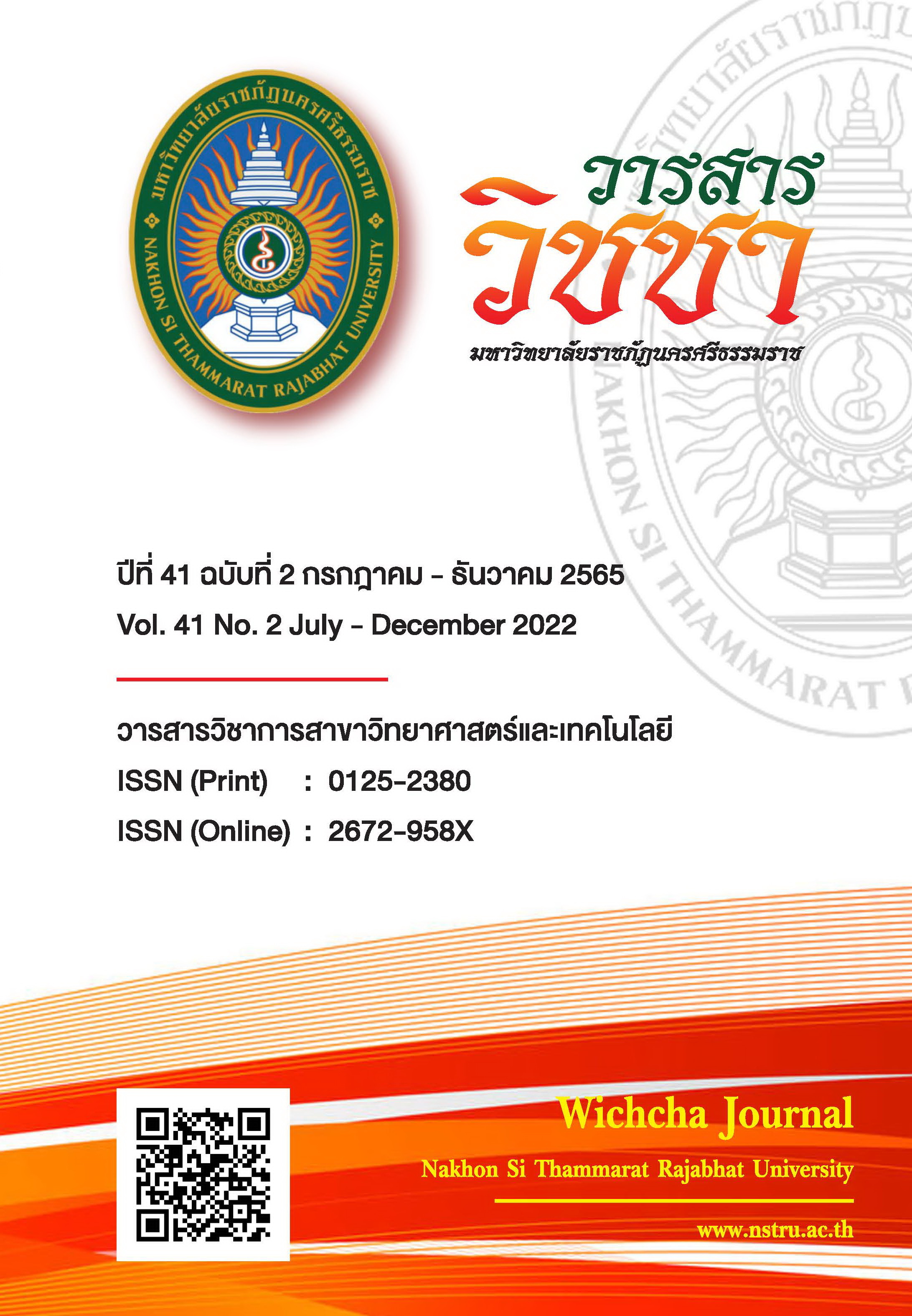The Phenology of Parah Tree (Elateriospermum tapos) at the Nature Trail with Different Terrain in Khao Nan National Park, Nakhon Si Thammarat Province
Main Article Content
Abstract
Parah (Elateriospermum tapos) is native to Southern Thailand. The seeds can be used for several kinds of processed food. The phenology of parah features seasonal changes with the main factor of light exposure around their buds affecting budbursts and leaf color. The purpose of this study was to analyze the phenology of parah in Nopphitam district and Tha Sala district, Nakhon Si Thammarat province, which both districts have different conditions of light exposure. The samples of parah were collected in Huai Lek Nature Trail (285 meters above sea level, 30 degrees average slope) and Hin Thor Waterfall Nature Trail (455 meters above sea level, 45 degrees average slope). Forty trees of parah were the representative for each site, and then the phenological analysis was conducted monthly for twelve months consisting of leaf color, flower, and seed weight. The results showed that the different geographical conditions of the two sites affected light exposure of the budbursts having an impact on the phenology of parah. The two sites had different phenological periods of one month. Instead of seed production of parah in both sites, there were no differences in terms of production. This study suggested that a period of seed harvest for each area should be determined for the benefits of sustainability from parah. Therefore, there should be further analysis including measuring light exposure around budbursts to uncover additional data.
Article Details

This work is licensed under a Creative Commons Attribution-NonCommercial-NoDerivatives 4.0 International License.
เนื้อหาและข้อมูลในบทความที่ลงตีพิมพ์ในวารสารวิชชา มหาวิทยาลัยราชภัฏนครศรีธรรมราช ถือเป็นข้อคิดเห็นและความรับผิดชอบของผู้เขียนบทความโดยตรง ซึ่งกองบรรณาธิการวารสารไม่จำเป็นต้องเห็นด้วยหรือร่วมรับผิดชอบใด ๆ
บทความ ข้อมูล เนื้อหา รูปภาพ ฯลฯ ที่ได้รับการตีพิมพ์ในวารสารวิชชา มหาวิทยาลัยราชภัฏนครศรีธรรมราช ถือเป็นลิขสิทธ์ของวารสารวิชชา มหาวิทยาลัยราชภัฏนครศรีธรรมราช หากบุคคลหรือหน่วยงานใดต้องการนำข้อมูลทั้งหมดหรือส่วนหนึ่งส่วนใดไปเผยแพร่ต่อหรือเพื่อการกระทำการใด ๆ จะต้องได้รับอนุญาตเป็นลายลักษณ์อักษรจากวารสารวิชชา มหาวิทยาลัยราชภัฏนครศรีธรรมราชก่อนเท่านั้น
The content and information in the article published in Wichcha journal Nakhon Si Thammarat Rajabhat University, It is the opinion and responsibility of the author of the article. The editorial journals do not need to agree. Or share any responsibility.
References
จุฑามาศ ศุภพันธ์ วีระเกียรติ ทรัพย์มี วรวิทู มีสุข จุติพร อัศวโสวรรณ ปะกิต ไชยธาดา เบญจพร จันทรโคตร จรัญ ด้วงแป้น พัฒนพร รินทจักร พินิดา งามไตรไร และอธิวรรธน์ บุญฤทธิ์. (2563). ลักษณะทางชีววิทยา ความหลากหลายทางพันธุกรรม และรูปแบบการกระจายพันธุ์ของต้นประในพื้นที่อำเภอนบพิตำ จังหวัดนครศรีธรรมราช. รายงานวิจัย. นครศรีธรรมราช.
ปริญญา หม่อมพิบูลย์ วันดี แก้วสุวรรณ อนุรักษ์ ตรีเพ็ชร และธราดล วัฒนนาวิน. (2561). แนวทางการพัฒนาเทคโนโลยีการแปรรูปผลิตภัณฑ์จากเมล็ดประในเชิงพาณิชย์. วารสารวิชชา มหาวิทยาลัยราชภัฏนครศรีธรรมราช, 37(พิเศษ), 113-128.
มานพ แก้วชัด ณรงค์ รักเคี่ยน วัชรพงศ์ ศรีแสง และศิริลักษณ์ ชุมเขียว (2550). ผลกระทบของการเปลี่ยนแปลงภูมิอากาศต่อต้นประ. รายงานวิจัย. นครศรีธรรมราช.
วิสุทธิ์ ใบไม้ และรังสิมา ตัณฑเลขา. (2550). เขานัน-ป่าเมฆธรรมชาติกับภาวะโลกร้อน. กรุงเทพฯ: กรุงเทพฯ จำกัด.
Borchert, R. (1994). Soil and stem water storage determine phenology and distribution of tropical dry forest trees. Ecology, 75(5), 1437-1449, doi: https://doi.org/10.2307/1937467.
Charoensuk, A., Jaroensutasinee, M., Srisang, W. and Jaroensutasinee, K. (2012). Parah forest clusters at Khao Nan national park, Thailand. Walailak Journal of Science and Technology, 9(4), 475-480, doi: https://doi.org/10.2004/wjst.v9i4.363.
Charoensuk, A., Tina, F.W., Jaroensuthasinee, M. and Jaroensutasinee, K. (2018). Predation and dispersal of Parah tree (Elateriospermum tapos) seeds by red spiny rats (Maxomys surifer) in Khao Nan national park. Journal of Environmental Biology, 39(1), 23-29, doi: https://doi.org/10.22438/jeb/39/1/MRN-588.
Chumkiew, S., Srisang, W., Jaroensutasinee, K. and Jaroensutasinee, M. (2007). Phenology of the Parah tree (Elateriospermum tapos) using a GAPS model. World Academy of Science, Engineering and Technology, 32, 207-211.
Cranbrook, E. and Edwards, D.S. (1994). A tropical rainforest: The nature of biodiversity in Borneo at Belalong, Brunei. London: The Royal Geographical Society and Sun Tree Publishing.
dos Santos, G.F., Kuster, V.C., Silva, A.F.M., Faria, A.P. and Moreina, A.S.F.P. (2021). Changes in color during leaf development of Eugenia uniflora (Myrtaceae): Different strategies for integrity conservation of the photosynthetic aaparatus. Australian Journal of Botany, 69(4), doi: https://doi.org/10.1071/BT20145.
Google Earth. (2020). Google Earth. Retrieved 23 June 2020, from: https://www.google.com/earth/.
Jantarit, S., Wattanasit, S. and Sotthibandhu, S. (2009). Canopy ants on the briefly deciduous tree (Elateriospermum tapos Blume) in a tropical rainforest, southern Thailand. Songklanakarin Journal of Science and Technology, 31(1), 21-28.
Kuhapong, U., Sornkliang, W., Sookkhathon, W., Thaiphan, R., Jaroensutasinee, M. and Jaroensutasinee, K. (2011). A study of Parah (Elateriospermum tapos) phenology at park renger station 5 Hui Lek. Wichcha journal Nakhon Si Thammarat Rajabhat University, 30(1), 13-19.
Ma, Y., Li, X., Gu. Z. and Li, J. (2019). Leaf color and growth change of Sedum rubrotinctum caused by two commercial chemical products. Hort Science, 54(3), 434-444, doi: https://doi.org/10.21273/HORTSCI13557-18.
Medway, L. (1972). Phenology of a tropical rain forest in Malaya. Biological Journal of Linnean Society, 4(2), 117-146, doi: https://doi.org/10.1111/j.1095-8312.1972.tb00692.x.
Niinemets, U., Kull, O. and Tenhunen, J.D. (1999). Varieability in leaf morphology and chemical composition as a function of canopy light environment in coexisting deciduous trees. International Journal of Plant Sciences, 160(5), 837-848, doi: https://doi.org/10.1086/314180.
Osada, N., Takera, H., Furukawa, A. and Awang, M. (2002). Ontogenetic changes in leaf phenology of a canopy species, Elateriospermum tapos (Euphoriaceae), in a Malaysian rain forest. Tropical Ecology, 18(1), 91-105.
Paker, G.G. (1995). Structure and microclimate of forest canopies. In Lowman, M.D. and Nadkarni, N.M. (Eds.). Forest canopy, pp. 73-106. California: Academic Press.
Reich, P.B. and Borchert, R. (1982). Phenology and ecophysiology of the tropical tree, Tabebuia neochrysantha (Bignoniaceae). Ecology, 63(2), 294-299.
Reich, P.B. and Borchert, R. (1984). Water stress and tree phenology in a tropical dry forest in the lowlands of Costa Rica. Journal of Ecology, 72(1), 61-74, doi: https://doi.org/10.2307/2260006.
Riha, S.J., Rossiter, D.G. and Simoends, P. (2003). GAPS: General purpose atmosphere-plant-soil simulator. New York: Cornell University.
Suppapan, J., Supmee, V. and Rinthajak, P. (2021). Genetic diversity of Parah tree (Elateriospermum tapos) in Nopphitum district, Nakhon Si Thammarat province. Phranakhon Rajabhat Research Journal (Science and Technology), 16(1), 115-126.
Whitmore, T. C. (1972). Euphorbiaceae. In Whitmore, T.C. (Ed.). Tree flora of Malaya volume 2, pp. 34-136. Kuala Lumpur: Longman.


